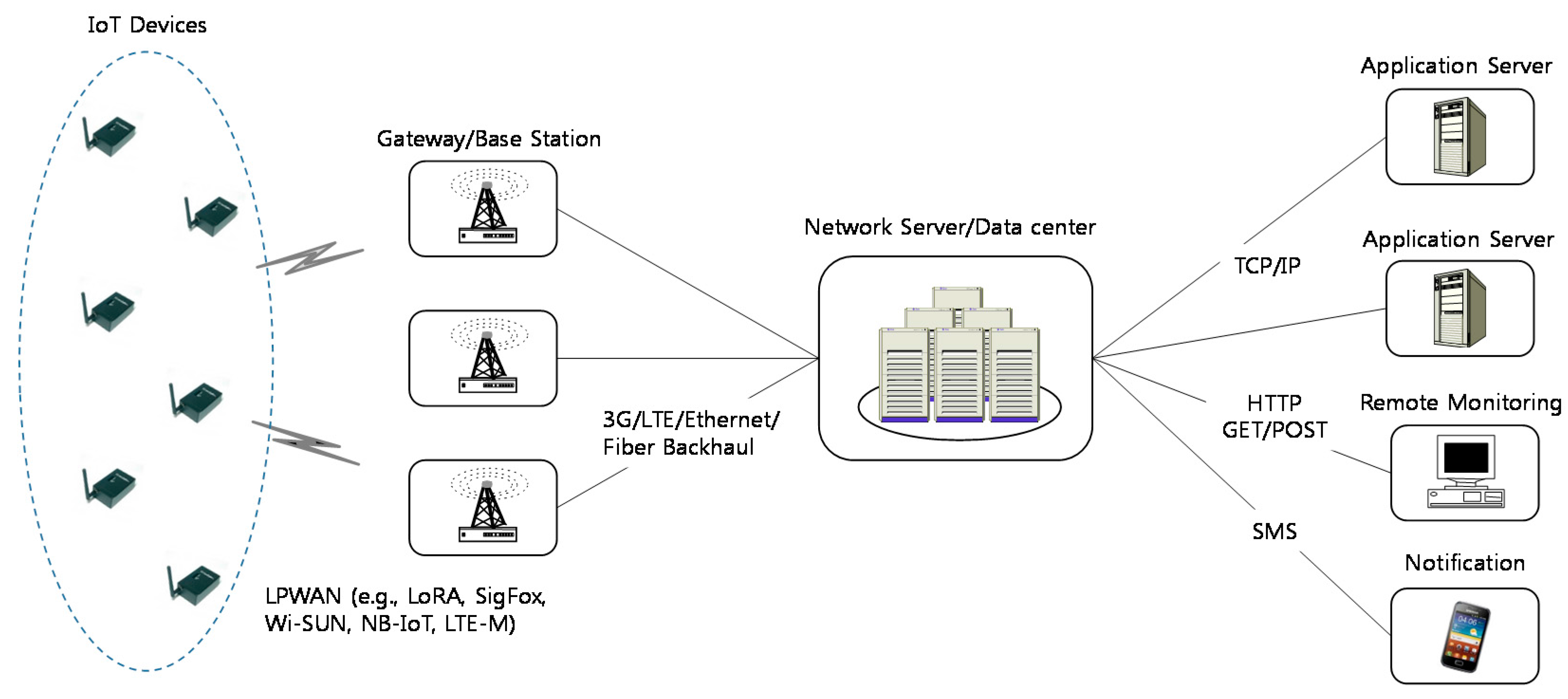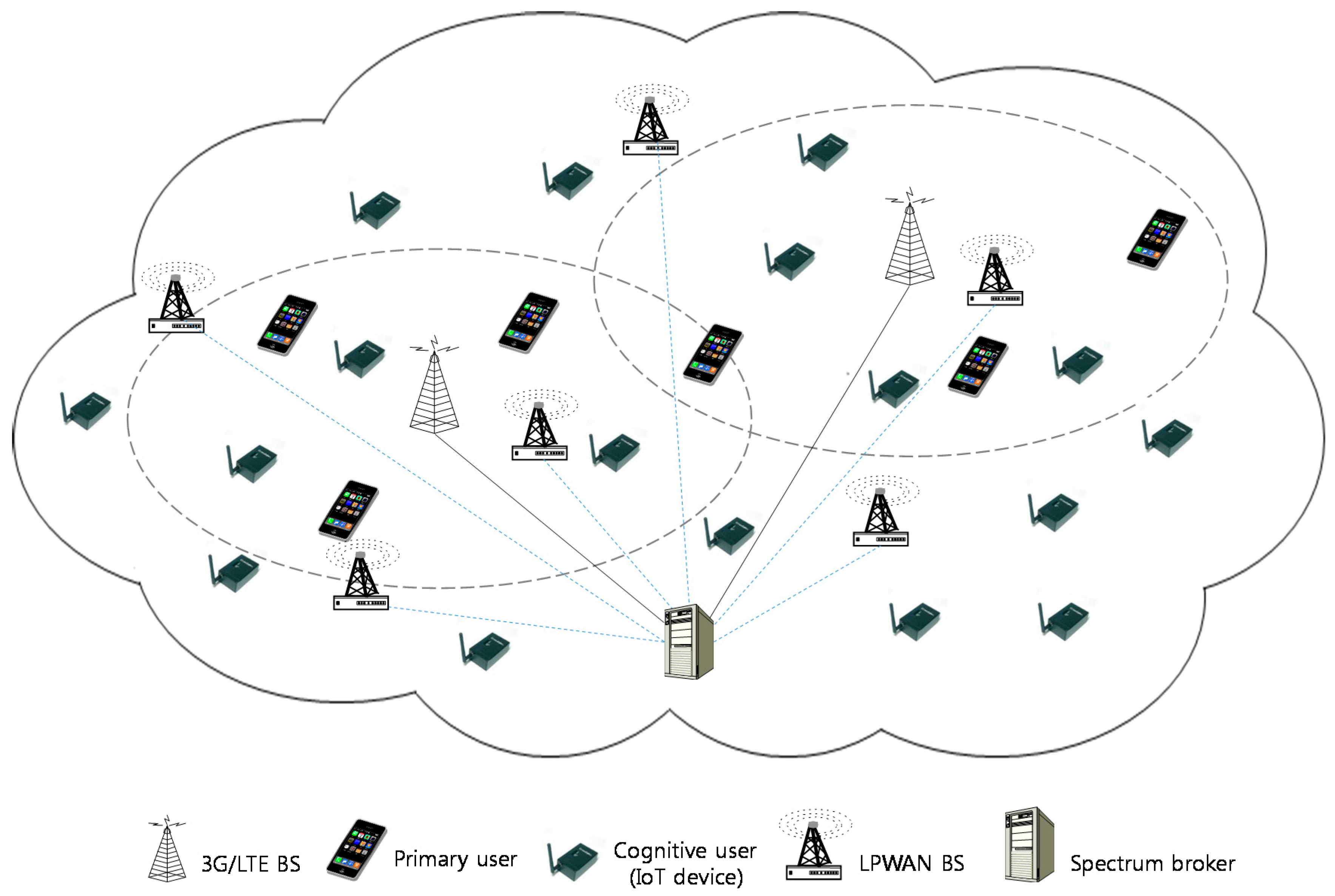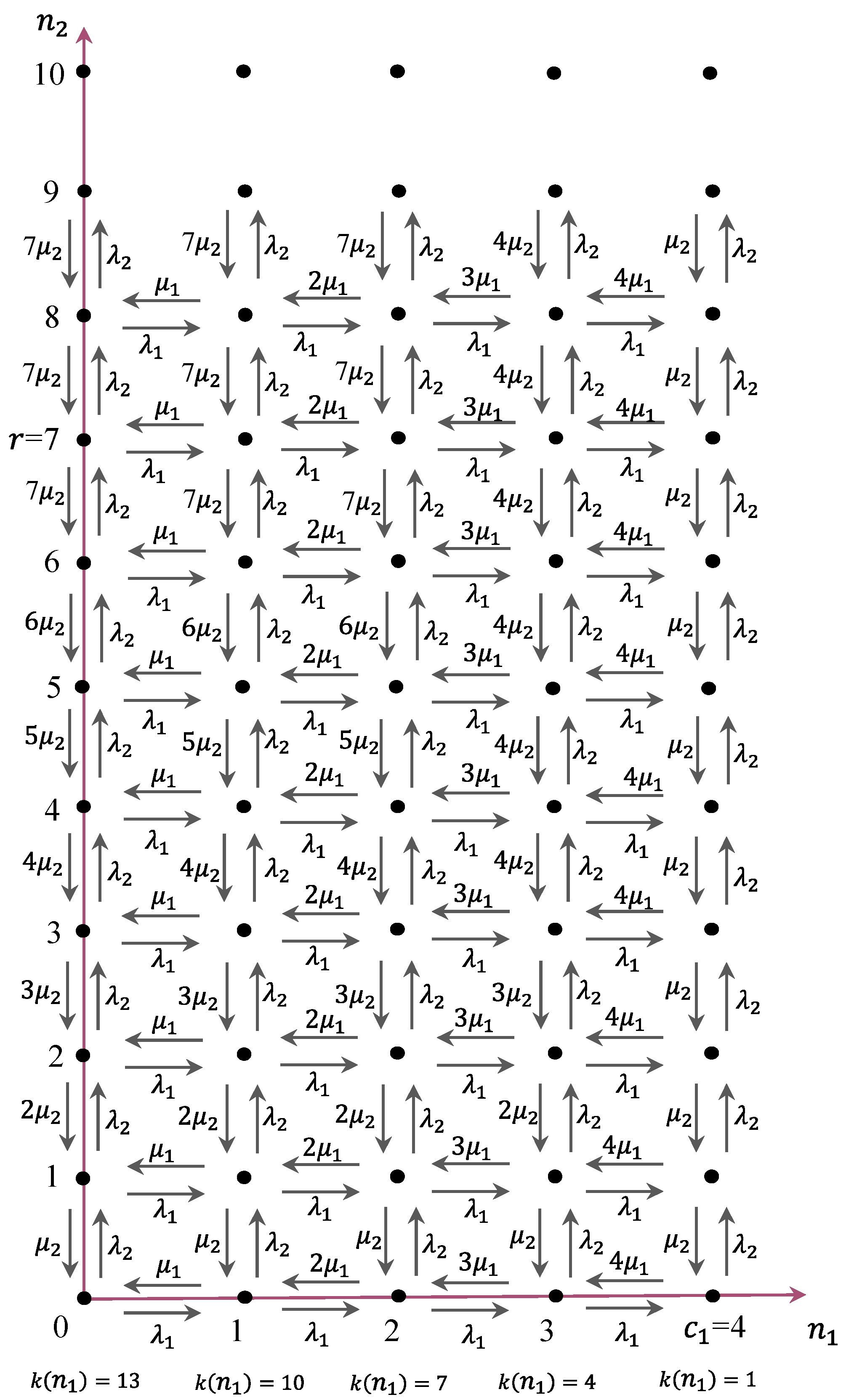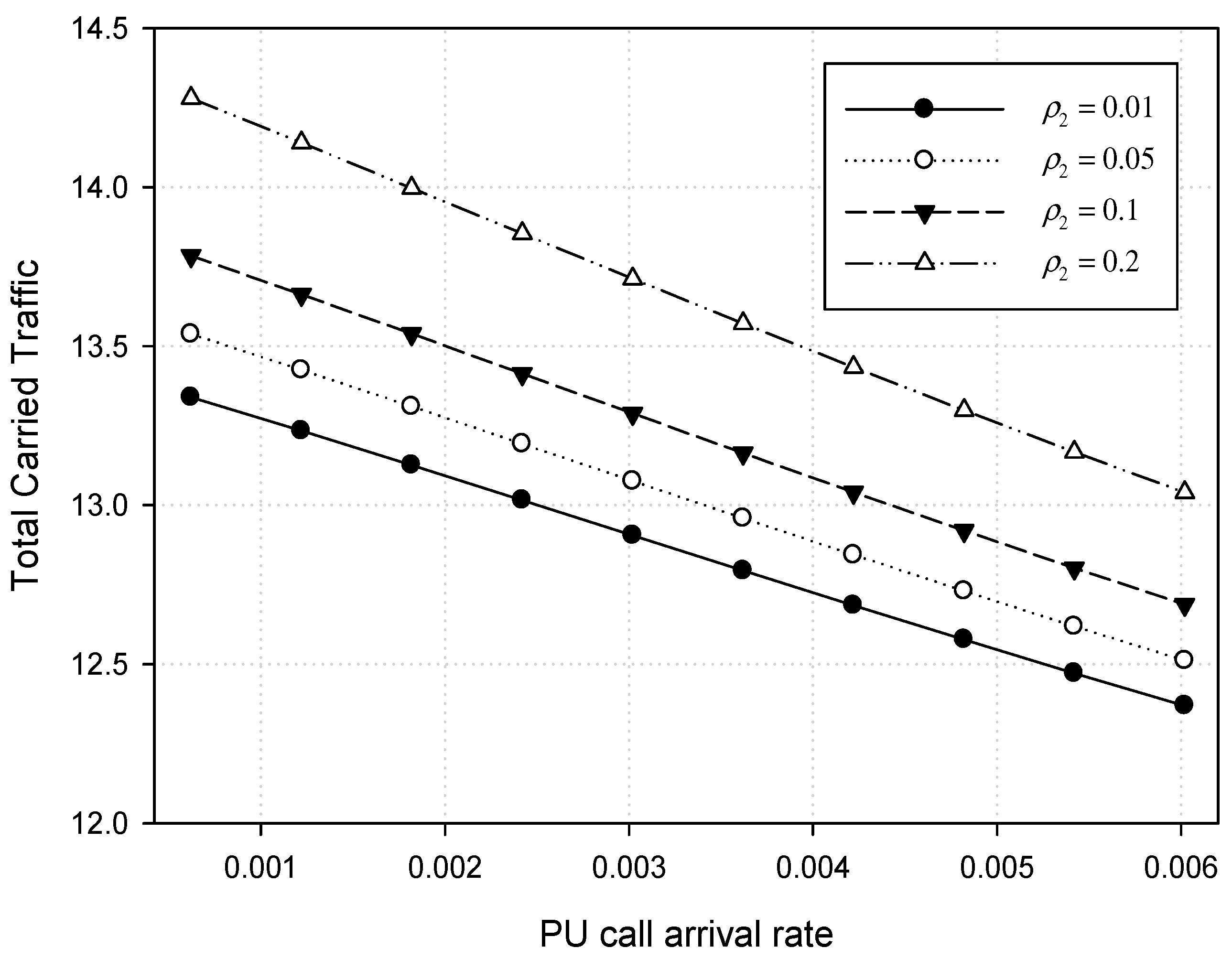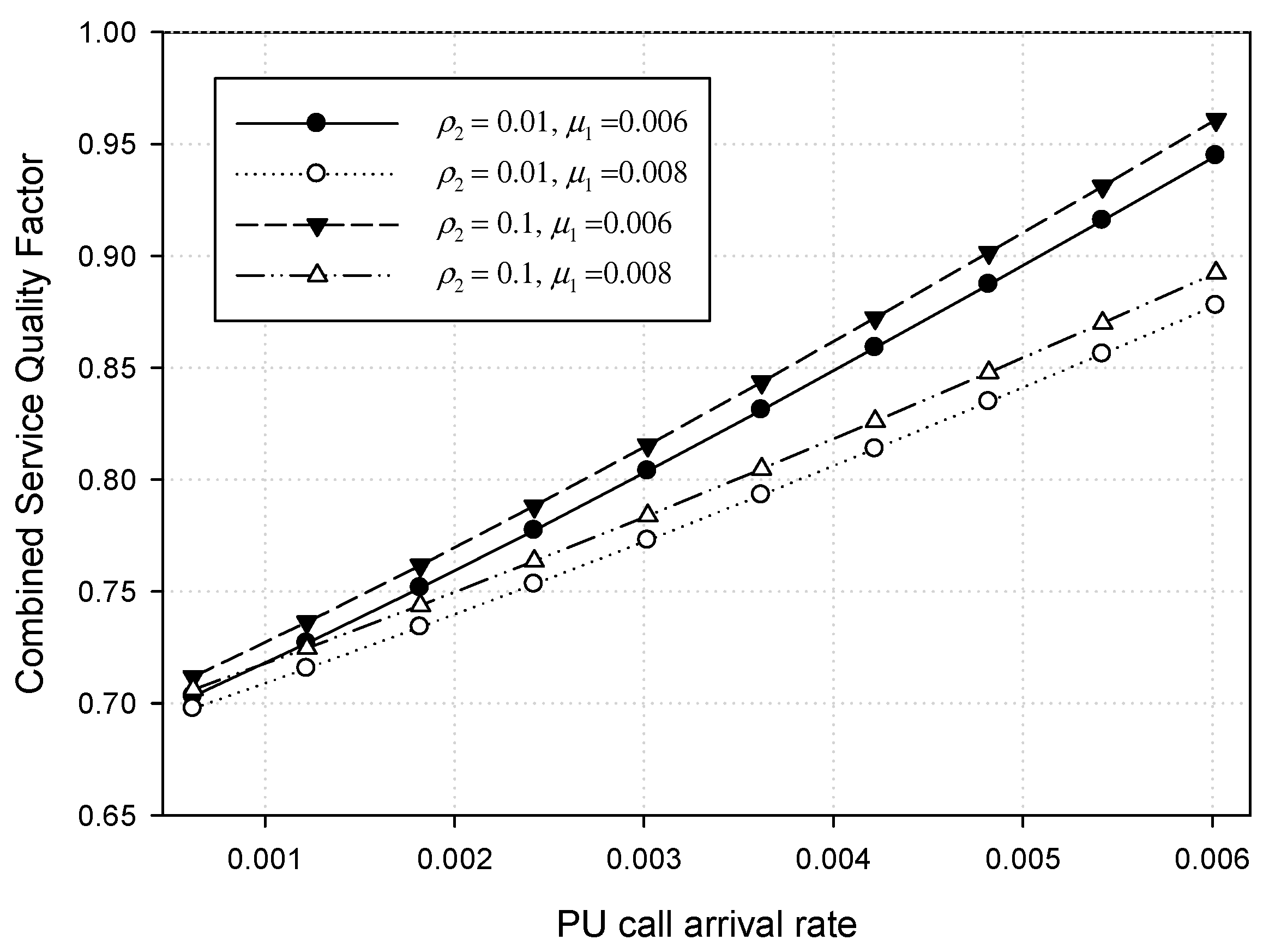1. Introduction
In general, service providers (SPs) for public radio communication need to pay the government the high cost for licensing of radio spectrum bands in the respective country. Once the spectrum bands are assigned, the amount of available spectrum in each band is fixed. In contrast, the industrial, scientific and medical (ISM) radio bands are exceptionally unlicensed radio spectrum although they are served with fixed spectrum allocation as well. Moreover, the unlicensed ISM band is suitable for building Internet of Things (IoT) services with flexibility and low cost without any restrictions on wireless coverage and network topology [
1,
2]. The traditional wireless sensor networks (WSNs) applications operate most commonly based on the 2.4 GHz unlicensed band under IEEE 802.15.4 standard. However, this band has often been overcrowded due to other wireless technologies such as WPANs (wireless personal area networks), WLANs (wireless local area networks), and WiMAX (worldwide interoperability for microwave access) operating over the same bands [
1,
3]. Recently, low power wide area network (LPWAN) systems such as LoRa [
2,
4,
5], SigFox [
2,
5], and Wi-SUN [
6], which operate most commonly under 800~900 MHz unlicensed bands, have been deployed commercially for IoT services even though the 3GPP NB-IoT [
5,
7] system still uses the licensed bands.
Since many licensed spectrum bands are often either underutilized or unutilized, unlicensed users can temporarily use the unused spectrum such as spectrum hole without interfering with licensed users. Cognitive radio (CR) techniques have been used to alleviate the limitations of spectrum in wireless networks. However, cognitive radio has a critical drawback that it must not cause radio spectrum interference to the licensed band. CR can avoid spectrum interference by altering its transmission. The CR can provide a network or a wireless node with the abilities to sense its environment such as spectrum holes, and change its transmitter parameters during communication. Thus, the CR attempts to get the best available spectrum through the interaction with its spectrum environment. That is, one aim of CR is to maximize the spectrum utilization for scare radio resources [
8,
9,
10,
11,
12,
13]. Until now, many researches have been done in order to cope with the coexistence of multiple wireless technologies in unlicensed spectrum bands in the WSNs [
14,
15,
16,
17,
18,
19,
20,
21].
Similarly, IoT devices can also exploit the potential advantages of cognitive techniques if they are equipped with CR. That is, they can manage the radio spectrum dynamically in the aid of the cognitive radio capabilities. The cognitive radio can be one of the most promising techniques for IoT systems since it improves spectrum utilization, increases network efficiency and extends network life. Consequently, this leads to the appearance of a new radio network paradigm for the IoT systems, called Cognitive Radio-enabled Low Power Wide Area Network (CR-LPWAN).
In CR-LPWANs for IoT systems, each device can sense the unused spectrum in both licensed and unlicensed spectrum bands. The unlicensed users can access the unutilized channels in licensed spectrum in the hope of improving the communication reliability and efficiency. That is, the licensed users can use the spectrum anytime, whereas unlicensed users can use the spectrum only when it is not used by the licensed user. More specifically, the cognitive radio-equipped unlicensed IoT device can select the most appropriate channel among the identified idle ones in the licensed spectrum band and can use it. If it is detected that a new licensed user arrives on the channel, the unlicensed IoT device moves to another spectrum hole and eventually vacates the channel. Hence, it becomes an important challenge for an unlicensed user to share licensed spectrum more efficiently without interfering with licensed users.
Our aim is to maximize the spectrum capacity for the unlicensed CR-enabled IoT network while ensuring that it never interferes with the licensed network. In this paper, therefore, we present a dynamic spectrum access strategy for cognitive radio-enabled LPWAN operating in both licensed bands and unlicensed bands. We also derive the blocking probability for the licensed users and carried traffic for the unlicensed users. In
Section 2, related works are investigated and CR-LPWAN architecture is introduced in
Section 3. A dynamic spectrum access model is presented and numerical analysis is given in
Section 4 and
Section 5, respectively. Results and discussions are presented in
Section 6. Conclusions are given in
Section 7.
3. System Architecture
If IoT devices are equipped with cognitive radio capabilities in LPWANs, they can work as a CR-based IoT system. In a CR-enabled LPWAN, wireless IoT devices collaboratively convey their event readings over idle spectrum channels. Some of the LPWANs share a single channel for communication, and an event sensing trigger causes the IoT devices to generate the burst traffic packets. Hence, many IoT nodes, within the specific event area in the densely deployed CR-LPWAN, seek to seize the same channel simultaneously. This increases the call blocking probability or packet losses, which cause transmission delay and excessive power consumption. Hence, it is necessary for CR-LPWAN to access a proper channel opportunistically among multiple channels to mitigate this latent challenge.
3.1. Internet of Things (IoT) Systems
The IoT system has cellular-like backbone network architecture as shown in
Figure 1. We assume that a CR-LPWAN is composed of IoT gateway (or base station) and IoT devices (or sensor nodes), which are uniformly distributed over the network area. These IoT devices can be assumed to adjust an arbitrary transmission power level for sustaining each data transmission. We also assume that there is at least one data transmission path from any IoT device to the gateway. The gateway node eventually collects all information acquired by each of the IoT devices. The collected information would finally be sent to the data server. In CR-LPWANs, each IoT device is responsible for determining its actions based on the local event readings. The local readings on each IoT sensor node need to be exchanged between the sensor nodes and central network server in order to broaden the sensing information on the entire network.
In addition to the event readings, IoT devices may exchange additional information with the network server. This information includes control data for spectrum allocation, and spectrum-handoff-aware channel determination, which depends on the specific topology. The typical duty cycle in CR-LPWANs, where IoT sensor devices are located geographically at random, depends on the sensing target. Path availability between the sensor nodes and the network server, and coverage intensity in CR-LPWANs can actually rely on the effective duty cycle.
3.2. Two Types of Radio Systems
Primary radio networks (PRNs) and CR-enabled LPWANs are considered for the two types of radio systems as shown in
Figure 2. The PRNs are mobile cellular networks where the fixed and licensed spectrum bands are often observed to be underutilized. CR-LPWANs work with PRNs and use their spectrum at a fixed frequency. Specifically, the spectrum channel contention between PRN and CR-LPWAN only takes place within the PRN radio spectrum range.
The licensed primary users (PUs) can exclusively use the spectrum bands allocated in PRNs. When PRN radio spectrum is not fully utilized, however, many spectrum holes in the PRN radio system can be temporarily used by the cognitive users (CUs) in CR-LPWANs. That is, CUs can identify and exploit these spectrum holes occurring in the PRN radio system. Specifically, CU should be able to exploit them to transmit in an opportunistic manner only when it does not interfere with any PUs.
In this architecture, IoT sensor devices send their reading values to the base station of LPWAN depending on spectrum availability by cognitive radio capability. The readings are eventually delivered to the data center, which is not indicated in
Figure 2 for simplicity. That is, cognitive radio-equipped IoT devices communicate with each other according to cellular-like topology over both licensed PRN bands and unlicensed CR-LPWAN spectrum bands. This topology creates less control data in communication and makes more accurate results in spectrum sensing. If IoT devices in a CR-LPWAN have mobility, it produces a more dynamic topology and enlarges the existing challenges.
3.3. Spectrum Broker
In channel allocation for dynamic radio spectrum sharing, an accurate prediction of network performance is important. In this architecture, a central spectrum broker is responsible for allocating radio spectrum channels to cognitive unlicensed users as shown in
Figure 2. A centralized sensing mechanism is performed for obtaining detailed information on unused frequencies although a decentralized sensing mechanism is also used. The transceiver on each IoT sensor device scans the spectrum availability and forwards the information of these spectrum holes to the spectrum broker via base station (or access point) in the respective network. The radio spectrum channel is allocated to the cognitive user on the IoT device depending on the number of unoccupied channels.
4. Dynamic Spectrum Access Model
The presence of spectrum holes in frequency spectrum allocation means that the radio spectrum is utilized inefficiently. Static radio spectrum access with the fixed resource allocation is not suitable for coping with spectrum shortages due to little resource sharing. On the contrary, dynamic spectrum access is good at handling spectrum holes or spectrum shortage by allocating the available bandwidth according to various approaches in an efficient manner. It should be able to apply different spectrum sharing to different systems as well as assign different fixed bandwidths to different systems.
Once media access control (MAC) or channel bandwidth allocation in LPWANs is well defined so that resource allocation can be easily made according to specific quality of service (QoS) in wireless applications, LPWANs can serve the traffic for wireless applications with strict QoS requirements. CR-LPWAN is especially efficient whenever the radio spectrum of a primary radio network (PRN) system with a large amount of resources becomes underutilized. Hence, in CR-LPWANs, the dynamic spectrum access is essential to efficient spectrum management for densely deployed IoT sensor nodes. CR-LPWAN is distinguished from traditional WSN by spectrum sensing functionality. Cognitive radio determines the vacant bands through the spectrum sensing capability by dynamically adjusting its operating parameters, and efficiently manages these available bands for improving the overall spectrum utilization.
4.1. Spectrum Access Model Under Two Types of Radio Systems
In this model, we consider the CR-enabled LPWAN overlapped with a primary radio network (PRN) such as the mobile cellular network. In this spectrum access model, frequency bands are used by two types of radio systems. One is the cellular network system operating in the licensed bands and the other is the wireless sensor network system operating in the unlicensed bands.
Similarly, there are two types of radio users, licensed PUs and unlicensed CUs. Typically, the unlicensed CU tries to use the available licensed channel. That is, the unlicensed users can access the licensed channel as long as they do not cause interference to the licensed users. Hence, when a PU begins to use an available licensed channel, the unlicensed CUs on IoT devices in CR-LPWAN, which operate on licensed bands in an opportunistic manner, must immediately detect the activity of licensed PU via spectrum sensing. That is, cognitive radio capability should be able to operate in licensed bands as well as unlicensed bands since the PUs do not always fully utilize the licensed spectrum bands.
Now let there be two types of radio users, PU and CU. In this model, the entire spectrum for two types of radio users actually consists of
M sub-band units. Each primary user uses an A-band channel consisting of
m sub-bands and each cognitive user uses a B-band channel consisting of only one sub-band. That is, one A-band channel is divided into
m B-band channels. The A and B-band channels overlap with each other in the same part of the entire spectrum, as indicated in
Figure 3, and the overlapped spectrum is used by both PUs and CUs. In more detail, a single cell of the primary radio network has
C1 (=
N) total channels, and CUs can only use some channels in the primary radio network beyond the channels (
C2) allocated in a CR-LPWAN. The PUs have priority to use the overlapped spectrum and can reclaim any sub-bands used temporarily by CUs. Therefore, the presence of CUs is entirely transparent to the PUs.
In
Figure 3, the primary users can use
N channels and the cognitive users can use
r (=
mK + C2) channels where
K = 0, 1, 2, …,
C1. The process of spectrum occupation is modeled as a continuous time Markov chain. It is characterized by its states and transition rates. The
mC1-(
M-
r) sub-band channels are shared by the primary users and cognitive users. In this case, the states are described by an integer pair (
i,
j), where
i is the total number of primary users and
j is the total number of the cognitive users. We assume the arrivals of primary users and cognitive users are both Poisson processes with arrival rates
λ1 and
λ2. The corresponding service times are exponentially distributed with rates
μ1 and
μ2.
4.2. Dynamic Spectrum Access Strategy
Typically, when the current channel condition becomes bad, the cognitive radio node can switch channel by spectrum handoff so that the on-going communication may be continued. In the proposed strategy, as the licensed PUs have the priority to use the allocated licensed spectrum bands over the unlicensed CUs in licensed spectrum bands, on-going CUs can be preempted by newly arriving PUs. That is, although the unlicensed users may temporally occupy the unused licensed sub-bands, they have to make these sub-bands vacant when the licensed users want to use them. Thus, in order for on-going CUs not to be dropped, the preempted CUs have to reconstruct the channels affected due to spectrum handoff. More specifically, when a PU begins to make a call for communication in licensed bands, the CUs have to move onto the vacant channel immediately after detecting the available channels in unlicensed bands by spectrum sensing. Whenever the cognitive users are newly preempted in primary licensed bands, however, spectrum handoff may succeed or fail depending on the number of channels occupied by cognitive users in licensed bands and the channels available in unlicensed bands.
In this strategy, CUs are allowed to overflow over the licensed spectrum allocated for PUs with the risk of being preempted by an arriving PU request. PUs can use up to BN channels from B1 channel with preemptive priority over CUs in any PRN cell, and A1 to Am(K−1) channels are dedicated to CUs. If the CUs are preempted by an arriving PU, they have to immediately move onto the available unlicensed channels by spectrum handoff. If the preempted CUs fail to move onto the available channel due to there being no vacant channel, they can be queued at the head of the infinite cognitive user queue (CUQ) to wait for service instead of being cleared. The newly arriving CU call is also queued if there is no idle channel to accept a CU call. Whenever the unlicensed spectrum bands become available, the channel band is allocated to the CU request at the head of the queue. All the entries of CU requests entering this queue are served on a first come first served (FCFS) basis, and the size of queue is assumed to be infinite. Since CU call requests are not rejected in this strategy, the queueing delay may also be very large (nearly infinite) in the worst case. Although the queue size never becomes infinite in a practical situation, it is considered to be infinite in order to evaluate the maximum delay theoretically without any restrictions in queueing delay.
Upon arrival of PU calls, a PU call is blocked and cleared if the number of PU calls in service is equal to BN or there are not enough free channels. In this strategy, no priority is given to PU handoff call attempts over PU new call attempts for simplicity of the analysis model, so no difference exists between these call attempts; the blocking probability and the probability of hand-off attempt failure are the same.
In general, two extreme cases can be considered for these two types of radio systems. If the cutoff value
r is restricted at
C2 in
Figure 3, the system will be two distinct spectrum band groups. However, this becomes clearly inefficient for IoT applications under LPWAN: CU calls might experience excessive delays while PU spectrum bands are unused. In another case, if the cutoff value
r is set for CUs to fully access the licensed bands (
C1 region) allocated for PUs, CUs can get more spectrum bands under heavy traffic of CU calls. However, random fluctuations in PU calls might severely harm CU call access. This situation also results in an excessive delay of CU calls due to the sudden preemption of many CU calls caused by arriving PU calls. This will be severe, since CU calls leave insufficient spectrum bands for accommodating an incoming PU call request, when the spectrum band ratio
m (= PU/CU) for PU and CU calls is large. In other words, large bandwidth ratios for PU and CU calls may result in drastic spectrum inefficiency.
The system can be protected by restricting the maximum number (= r) of CU calls that can be in service at the same time. That is, the excessive delay of CU calls caused by the suddenly arriving PU calls can be protected by setting some restrictions on the CU calls. Therefore, it is natural to choose the cutoff values r that make the available channels for CU calls in licensed spectrum bands a multiple of the spectrum channel of a PU call. The cutoff value r needs to be adjusted in order to find good tradeoff between more spectrum availability and excessive delay experience for CU calls.
6. Results and Discussions
In this dynamic spectrum access model are heterogeneous types of traffics and their traffic characteristics. In this section, the numerical analysis results are presented in order to illustrate the performance characteristics of a dynamic spectrum access strategy for a system with
M = 13,
m = 3,
c1 = 4,
r = 7 as shown in
Figure 3. In
Figure 6, we can see the blocking probability for PU calls when the PU traffic load
ρ1 (=
λ1/
μ1) varies from
λ1 = 0.0006 to 0.006 under
μ1 = 0.006 and 0.008, respectively. Meanwhile, the CU traffic load
ρ2 (=
λ2/
μ2) is kept constant at 0.01 with
λ2 = 0.2 and
μ2 = 20. From the dynamic spectrum access strategy shown in
Figure 3, it can be seen that the blocking probability for PU calls only depends on
λ1 and
μ1 since the PU traffic is independent of CU traffic. Simulation is also performed together in order to verify the correctness of the mathematical analysis for the proposed dynamic spectrum access strategy. In
Figure 6, the blocking probability for PU calls in the simulation is a little higher than that of the mathematical analysis overall. Before
λ1 reaches 0.001, however, the blocking probability in the simulation is much lower than that of the mathematical analysis, and soon it becomes higher than the analysis result at around
λ1 = 0.0012. In
Figure 6, the difference between the simulation and the analysis of the blocking probability for PU calls is kept at a similar rate as
λ1 increases to 0.006. Hence, the mathematical analysis can be verified with a similar upward tendency in distance.
Figure 6 also shows that the blocking probability under
μ1 = 0.006 is 13% more than under
μ1 = 0.008 in both the simulation and the analysis as
λ1 increases to 0.006.
Figure 7 shows the mean dwell time for CU calls when the PU traffic load
ρ1 varies from
λ1 = 0.0006 to 0.006 with
μ1 = 0.006. Meanwhile, the CU traffic load
ρ2 is kept constant at 0.01, 0.1, and 0.99 (≈ 1.0) with
λ2 = 0.2. Now we can consider the effect of the channel bandwidth ratio
m on the mean dwell time of CU calls. In this example, CU call attempts can be overflowed into PU spectrum channels or can be queued in the CUQ when enough channels are not available. Under the heavy PU traffic, therefore, an arriving PU request makes
m CU calls preempted, and then these CU calls can be queued unless they fail to move onto available channels. Consequently, the longer the time spent in the CU queue, the more the mean dwell time for CU calls increases. In
Figure 7, however, we can see that the CU mean dwell time is slightly reduced as PU traffic load increases. This means that the licensed spectrum channels allocated for PUs are quickly occupied under heavy PU traffic, and hence no CU calls can overflow over the licensed spectrum.
Meanwhile, it is shown that the mean dwell time also increases when CU traffic load increases.
Figure 7 shows the variation among the values in the mean dwell time according to different CU traffic load (
ρ2) at 0.01, 0.1, and 0.99 (≈ 1.0). Since CU calls often fail to get channel allocations under the heavy CU traffic in this example, the CU calls can be queued more frequently. Now we can infer the effect of the ratio (
μ2/
μ1) of mean service time on the mean dwell time of CU calls. In
Figure 7, the spectrum performance of CU calls is better when the service time ratio (
μ2/
μ1) is larger even though the PU service rate (
μ1) is kept constant at 0.006. On the contrary, this means that the average dwell time of CU calls increases as the spectrum channel holding time of PU calls becomes longer. This phenomenon is common in the movable boundary strategy.
Figure 8 shows the total carried traffic when PU traffic load
ρ1 varies from
λ1 = 0.0006 to 0.006 under both
μ1 = 0.006. Meanwhile, CU traffic load
ρ2 is kept constant at 0.01, 0.05, 0.1, and 0.2 with
λ2 = 0.2.
Figure 8 also shows the variation among the total carried traffic according to different CU traffic load (
ρ2) at 0.01, 0.05, 0.1, and 0.2. In this example, the total carried traffic also increases when CU traffic load increases. The CU channel allocation failure under the heavy CU traffic load often makes the CU calls queued more frequently. This may be explained as follows: if CU traffic enters into a few channels that the PU spectrum band leaves for the overloaded CU traffic, the continuous CU call attempts can make the queue grow. At this point, an arriving PU request makes
m CU calls preempted as PU traffic increases, and this makes the CU queue size increase. In this situation, if the service time of the PU call becomes longer, this builds up a significant queue size. In
Figure 8, however, we can see that the total carried traffic is slightly reduced as PU traffic load increases. This means that no CU calls can overflow over the licensed spectrum since the licensed spectrum channels allocated for PUs are quickly occupied under heavy PU traffic. That is, when the CU traffic load is switched to a normal situation, the queue size is continuously reduced and approaches its steady-state level. This phenomenon depends on the service time ratio, cutoff values, and the ratio of the spectrum bandwidth required for each type of traffic.
Figure 9 shows the combined service quality factors when the PU traffic load
ρ1 varies from
λ1 = 0.0006 to 0.006 under
μ1 = 0.006 and 0.008, respectively. Meanwhile, the CU traffic load
ρ2 is kept constant at 0.01 and 0.1 with
λ2 = 0.2 and weight factor
WGT = 3.0.
Figure 9 also shows that the combined service quality factor (CQF) increases at nearly the same rate as
λ1 increases to 0.006. In this example, the CU arrival rate (λ
2) is fixed as 0.2. That is, the lower the CU service rate (
μ2) is, the higher the CU traffic load (
ρ2) is. Hence, the higher the CU traffic load is, the better the CQF is. In
Figure 9, it is shown that the CQF when
ρ2 is 0.1 is better than the CQF when
ρ2 is 0.01. Meanwhile, as shown in
Figure 6, the higher the PU service rate
μ1 is, the lower the blocking probability of the PU call requests is. That is, the higher the service rate (
μ1) is, the better the CQF is. In
Figure 9, however, we can see that the CQF when
μ1 is 0.006 is better than the CQF when
μ1 is 0.008. This can be explained as follows: the lower
μ1 is, the longer the PU spectrum channel is occupied. In this situation, the rate that CU traffic overflows into the PU spectrum channel and then is preempted again, becomes lower than the situation with the higher
μ1. This makes CU calls queued more frequently due to preemption and delayed more due to this queueing. Consequently, the CQF becomes lower in the higher service rate (
μ1).
